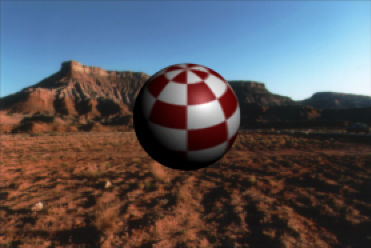
You can import an image, a series of image files, or a movie file and map them to an image plane to act as a backdrop for your scene. You can use this backdrop in the following ways:
- As a reference while you build your scene.
- As the background for your scene instead of you having to build it all.
- To catch shadows and reflections with the Use Background material (see Shadow catching).
- To produce environments with Environment textures.
There are two types of image planes:
- Free image planes that are not attached to a camera, which you can select and transform freely.
- Image planes that are attached to a camera. These are automatically created at the camera's far clipping plane.
They are perpendicular to the camera and parented to it so that even when a camera moves or changes the point of interest, the image plane still covers the entire view behind your scene.
You can include depth information in your image plane if it is an .exr or .iff file with a depth channel. See Depth compositing with image planes.
You can create multiple image planes to add interesting backgrounds, ordered by depth. To create, edit, or position an image plane, see Create, edit, or position an image plane.
Image plane attributes and caching
The Image Plane Attributes control the appearance and placement of an image plane. For a detailed description of image plane attributes and guidelines on how to change them, see Image plane attributes.
Cached Playback supports image planes, but only if you set Evaluation Cache as the Caching mode. See Choose a mode for cached playback for more information on Caching modes.
Image plane syntax
When you import an image as an image plane, the syntax must be as follows:
- name.#
- name.#.ext
Static image file backgrounds
A static image file background uses a single image file as a background. The background image does not change during an animation.
To create a static image file background, see Create a static image file background.
Animated image file backgrounds
You can create an animated image file background using either a series of image files or a movie file. (A movie file updates in the views much faster than a series of image files.)
To create an animated image file background, see Create an animated image file background.
3D background simulations
An image file background is a 2D image that exists behind the objects in the scene. You can, however, simulate a 3D background by creating “stand-in” surfaces that represent objects in the background image. An object in the scene can then:
- move behind an object in the background image.
- cast shadows onto objects in the background image.
- receive shadows from objects in the background image.
- be accurately reflected by the objects in the background image.

- Create a 3D image file background.
- Create a static image file background.
-
Create an animated image file background.
Attention:
Before you create an image file background, you should set up the camera and the camera’s view so that it matches the camera used to record the background image. For more information about setting up cameras, see Maya camera types.
Note:It is also possible to create a 3D image file background so that the objects in the scene accurately reflect the objects in the background image.